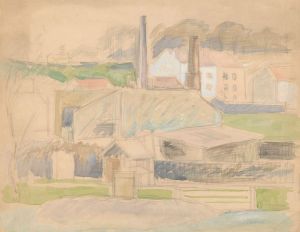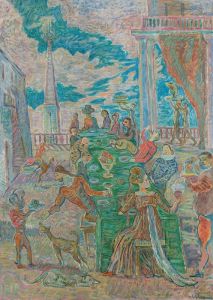
Singer
A hand-painted replica of Zygmunt Waliszewski’s masterpiece Singer, meticulously crafted by professional artists to capture the true essence of the original. Each piece is created with museum-quality canvas and rare mineral pigments, carefully painted by experienced artists with delicate brushstrokes and rich, layered colors to perfectly recreate the texture of the original artwork. Unlike machine-printed reproductions, this hand-painted version brings the painting to life, infused with the artist’s emotions and skill in every stroke. Whether for personal collection or home decoration, it instantly elevates the artistic atmosphere of any space.
Zygmunt Waliszewski was a Polish painter known for his contributions to the art world in the early 20th century. Born on October 1, 1897, in Saint Petersburg, Russia, Waliszewski moved to Poland where he became an influential figure in the Polish art scene. He was associated with the avant-garde movement and was known for his vibrant use of color and dynamic compositions. His works often reflected a blend of various styles, including elements of Post-Impressionism and Expressionism.
One of Waliszewski's notable works is "Singer," a painting that exemplifies his unique artistic style. While specific details about the painting "Singer" are limited, it is known that Waliszewski's works often depicted scenes of everyday life, infused with a sense of energy and emotion. His paintings frequently featured bold colors and expressive brushwork, characteristics that likely carried over into "Singer."
Waliszewski's artistic journey began with his studies at the Academy of Fine Arts in Kraków, where he was influenced by the teachings of prominent artists of the time. His exposure to various art movements during his travels across Europe further shaped his artistic vision. Waliszewski was part of the "Formists," a group of Polish artists who sought to break away from traditional art forms and explore new, modernist approaches. This influence is evident in his work, which often challenged conventional techniques and embraced a more abstract and expressive style.
The painting "Singer" is believed to capture the essence of Waliszewski's approach to art, focusing on the emotional and expressive potential of the subject. While the specifics of the painting's composition and subject matter are not extensively documented, it can be inferred that Waliszewski's interest in music and performance might have played a role in the creation of this piece. Music and performance were recurring themes in his work, reflecting his fascination with the dynamic interplay between sound and visual art.
Waliszewski's contribution to the art world extends beyond his paintings. He was also involved in theater and stage design, further showcasing his versatility as an artist. His ability to blend different artistic disciplines and his innovative approach to painting earned him recognition and respect among his contemporaries.
Despite his relatively short life—Waliszewski passed away on October 5, 1936, in Kraków—his impact on Polish art was significant. His works continue to be celebrated for their vibrant energy and emotional depth. Today, Waliszewski's paintings, including "Singer," are held in various collections and museums, serving as a testament to his enduring legacy in the world of art.
In summary, Zygmunt Waliszewski's "Singer" is a reflection of his distinctive style and artistic vision. While specific details about the painting are scarce, it remains an important part of his body of work, illustrating his contribution to the modernist movement in Poland. Through his innovative use of color and form, Waliszewski left an indelible mark on the art world, influencing future generations of artists.
















